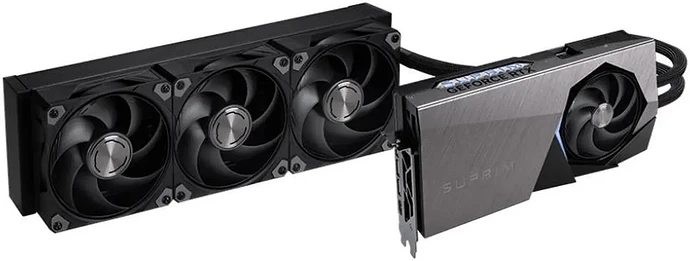When NVIDIA launched the GeForce RTX 5090, the first thing our build team at Arsenal PC noticed wasn’t the power draw… it was the heat. These cards are absolute monsters, with a minimum 575W TDP, and even higher on some aftermarket models. Up to this point, the most power-hungry card was “only” 450W (GeForce RTX 4090.) Naturally, we had to ask: does liquid cooling finally make more sense than traditional air cooling for a card with this much heat output?
Pictured above: an MSI Suprim Liquid SOC GeForce RTX 5090 graphics card
Here’s what the Arsenal PC Research & Development lab found in our own testing over the past few weeks:
- Thermal performance: Air-cooled RTX 5090 cards regularly run in the 80–85°C range under sustained gaming or AI workloads. An AIO liquid cooler can drop that by 10–15°C, depending upon overall case airflow. The RTX 5090’s thermal design limit is 90°C, after which point the card will thermal throttle itself for safety. We have yet to be able to replicate a thermal throttle event, even with an air-cooled RTX 5090.
- Noise: Air coolers have a tendency to need to ramp the fans aggressively once the GPU is under load. Liquid cooling solutions are quieter in sustained workloads, but add pump noise into the mix. Overall still considerably quieter, but the pump noise may stand out.
- Reliability: Air coolers are dead simple — fans eventually wear out, but that’s it. Some add-in board partners like XFX have even made fan replacement as simple as detaching a magnet. With liquid cooling, you introduce the risk of pump failure or coolant leakage, although today’s sealed AIO liquid coolers are more reliable than they’ve ever been.
- Practical build constraints: With air coolers that extend down into a fourth expansion slot when installed into the case, new GPUs are heavier than ever, which introduces increased risk of damage to the motherboard’s PCIe slot, and can cause GPU sag over time. Using a GPU with an AIO liquid cooling solution alleviates these concerns, but requires additional radiator mounting space — which not every case can accommodate, especially if you’re already running a CPU AIO.
- Custom loops: While GPUs are available with pre-installed AIO liquid coolers (such as the Astral LC), some users may prefer to jump to a custom liquid cooling solution involving custom tubing, a separate pump/reservoir, a distribution block… while these solutions are objectively the best cooling available, they require regular maintenance; additionally, not very many GPUs are available with pre-installed blocks, the resale value on those GPUs is considerably worse as the secondhand buyers’ market for a used waterblocked GPU is nearly non-existent, and you run increased risk of failure from leaks or improper installation.
Our current takeaway: air cooling is still more than sufficient for most users, provided you choose a case with excellent airflow. We’ve found that even dual air-cooled RTX 5090 cards installed into a single system stay well within thermal limits under sustained load. (Stay tuned for the launch of that workstation!) Liquid cooling becomes more relevant for enthusiasts chasing absolute silence, or users who want, objectively, the best cooling available without compromise.
What about you? If you were buying an RTX 5090 today, would you pay extra for a liquid-cooled version, or stick with air cooling and a well-ventilated case? Let us know in the comments section below.
Interested in a professionally-built custom gaming PC featuring the GeForce RTX 5090 graphics card? Browse our selection of high-end PCs with various GPU options, including the venerable RTX 5090, right here on our official Newegg store page!
